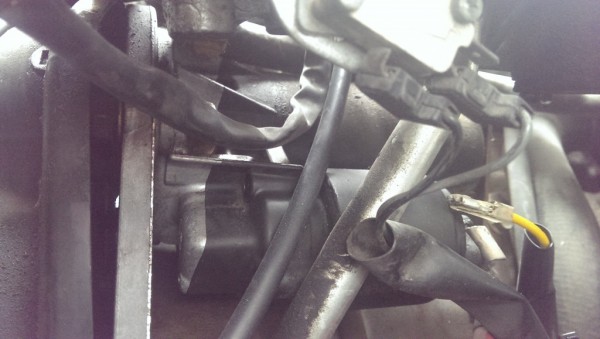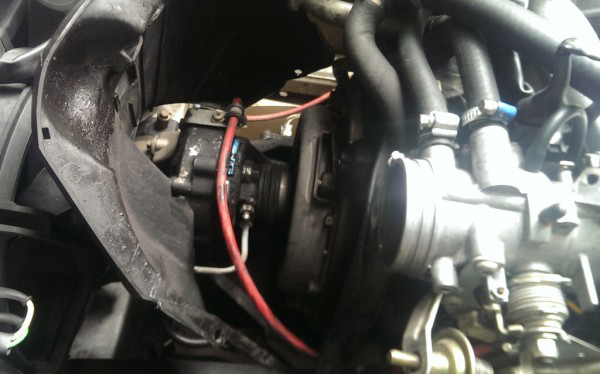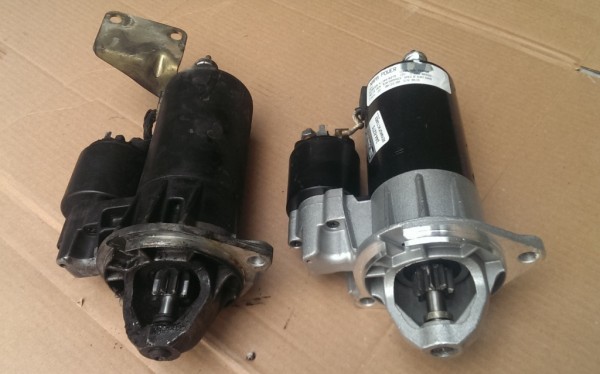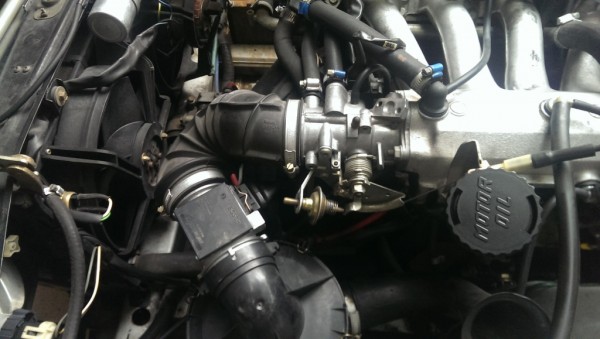After my gripe session the other day, I decided it was time to get the SAAB back on the road yet once again. After a few quick tests with my trusty multimeter, I determined that the starter was indeed bad. That multimeter has been my best friend when working on this SAAB by the way. It is always a good idea to test components before replacing them because it saves you time and money. Anyway, after picking up a replacement starter from the local auto parts store, I went online to get some pointers before starting the job. Most of the forums were filled with complaints about the task. Some even saying that SAABs were good cars, all except for the location of the starter. Can you spot it hidden under there? I don’t think it was that bad of a job, but it was definitely a challenge that I’d rather not undertake again.

The problem here is the location of the starter. It is right under the intake manifold so access can be awkward at times. That and the fact that the starter itself is held in place by a pair of bolts that can only be accessed after removing a large plastic clutch cover. This all sounds complicated, but it’s really not that confusing if you know what to remove first. Some advice online said that the task could be done without removing the plastic panel and there was proof that someone had attempted that very technique here. I figured I would save myself some headaches and just follow the steps as they were presented in the workshop manual though. Without any direction, I’m sure this job would have been even more frustrating than it already was, so I would recommend following the instructions for once here.

Before doing anything, I made sure to disconnect the battery. Then after removing a handful of bolts, I carefully pried the previously mentioned plastic cover out. As you can see, the cover is there to protect the clutch and removing it made the job infinitely easier because the bolt heads on the other side of the starter were then easily accessible. I suppose I could have shoved an open end wrench under the edge of the cover to hold the bolts in place, but there wasn’t much room to work in there so it would have been tough going. The whole thing was a contortionist act already with multiple sizes of sockets and extensions needed to fit through the openings in the intake manifold and hose-cluttered space underneath. After loosening the bolts on the front and then the ones on a bracket in the back, the starter was loose. I then had to remove the air filter box and navigate a few wires and hoses before I could wiggle the starter out.

Everything went right back together in reverse order without any issues. It was a little tough getting that plastic cover to bend enough to go back in place, but after that, reassembly was pretty straightforward. There were many different sizes of bolts used on these cars and some star head screws, so my toolset got a good workout. After tightening everything up and reconnecting the battery, I anxiously sat down in the driver’s seat to give it a try. I pushed in the clutch, held the brake, and gave the key a turn… She cranked a few times and then sputtered to life once again. So as suspected, the starter was the culprit in this round of gremlin chasing!
Latest Project Updates
- September 25, 2014 – Say So Long To Our SAAB Project
- August 26. 2014 – The Dreaded Starter Swap
- August 13, 2014 – Ready To Move On
- June 10, 2014 – Digital Detective Work
- May 19, 2014 – Running Rough When Warm
- May 12, 2014 – Back in Service, Sorta
- May 6, 2014 – In the Junkyard Again
- April 18, 2014 – Who Needs a Truck When You Have a SAAB?
- April 3, 2014 – My Saab Story


A good result, well done.
Hats off to all those who spanner on their own rides.
& this sounds relatively easy compared to a starter motor replacement on an Alfa Milano. That’s buried under the exhaust manifold, hard up against the firewall, on a V6 motor crammed into a 4 cylinder engine bay – perseverance wins in the end … Its not something you’d want to pay hours for a mechanic to learn.
the starters are are a pain to replace but the clutch is a lot easier to replace then on most car. if you want a real hard job on a 900 try replacing the blower motor for the heat/A/C. are you still trying to sell it? ( no i am not interested in buying a saab ). thanks for the update. how is the miata doing?
Luckily my heater motor is alright… For the time being anyway. It is still for sale, but I figured I had better fix a few more things before moving it on. I always like to leave my cars better than found. I’m a little worried about finding a buyer for this one though. Seems like there are fewer and fewer people interested in these all the time. Too bad actually. My little rants here on the site probably aren’t helping matters though.
The Miata is doing great! Apparently too great because there has been nothing major to report. I have reinstalled the original radio and am currently looking for a new trim piece to replace the cut one. I also removed the aftermarket rearview mirror and replaced it with the original. The aftermarket one had nice built in maps lights, but it was vibrating like crazy. Basically, the car will be back to being completely stock and original. Oh, I did remove the sun visor to give my tall self a better line of sight, but that can always go right back in. This Miata has been a fun daily driver and I love it more all the time. People that don’t think these will be considered classics soon are crazy!
sounds like you are having fun with the miata. i hope the prices on the older ones do not start to go up anytime soon.
There is a reason why Saab went bankrupt in 2010 and again in 2014.
What about GM and Chrysler? Snippy comments by those lacking factual information are the down fall of the internet!
….GM owned Saab at that time
All you do is complain about this car. Why do you think somebody would want to buy it after you piss and moan about the car every chance you get? Please do us all a favor and sell it if you aren’t going to embrace owning a classic 900. And there are plenty of resources available to research before you tackle repairing anything else. Here’s one for the starter:
http://www.saabcentral.com/forums/showthread.php?t=159365
Perhaps I should be more positive dino7. The SAAB is just as easy to work on as any other fuel-injected car from the eighties… I may have hurt my chances of selling the car, but I have also been honest in sharing my ownership experience. There is a good reason that most people seek out pre-1976 cars to tinker with. Smog equipment and sensors are a pain for most shade tree mechanics. Don’t get me wrong though, I appreciate the classic 900s for their innovative engineering and would be first in line to buy a new one if they started producing them again!
Jesse,
Pay the critics no mind! Any job worth doing is worth doing some complaining about and no tough job can be truly done well without some frustration and a few swears! More of us than not can relate to the experiences you’ve relayed about your Saab. Anyone in this hobby that claim to have purchased an old car and not, at one point or another, said “what the hell did I get myself into?” is a complete liar! This hobby, just like anything else in life, has good times and bad. It doesn’t matter if it’s a complex Saab or a rusty ’49 Chevy, the experiences you gain make you a better mechanic, body man, painter, etc…etc…education is not always easy and not always fun, but worthwhile. Besides, guys into cars all know that “just ’cause your complainin’ don’t mean you ain’t havin’ fun!”.
As much bad that gets blamed on the internet, fraud and such, it really is a wonderful resource when you need to fix something! Because of it, I’ve been able to make repairs ranging from cars to a non-working Craftsman table saw that I was given. Sometimes the repair manual just isn’t clear (or I’m just not gettin’ it) and a search online gets me back on track!
Equally, sometimes it’s best to read up on the task a few days before tearing into it. Sometimes, things like pesky clutch cover removal jobs just need to sink into my head for a few days first, so when I actually start to work, I’ve come to terms with the fact that I will be spend an extra hour fiddling to remove a “damned stupid cover”, thus allowing me to work at it without emotion (nice word for anger and resentment) and avoiding stupid mistakes caused by rushing, like trying to remove the starter without removing the cover first and breaking something.
Starter change takes 16 minutes on this model… Done it many times!!!
That’s impressive Sean! I suppose that once you have the process figured out, it is easier the second time around.
The flywheel/clutch cover does need to be removed, an open end wrench can be pushed between the gap onto the bolt heads. The airfilter housing with mass airflow sensor comes out as a unit. Remove/loosen the little inlet manifold/throttle housing brace and one is pretty much home free. The starter support bracket is removed and installed with starter in place, the larger bolts using a long extension (several feet long). It looks much worse then reality is, much better then when the starter was under the exhaust manifold…
IMHO, complaining about the location of starters and other components on certain cars is part of the territory when you work on your own, especially if you don’t have experience with the job. Some of the newer cars we drive can be pretty difficult to work on. Even the pros will tell you that, and then list the tough jobs they dread seeing come into the shop, especially with FWD cars.
So please consider that dino7, and try to remember to give us a break if we don’t jump for joy the next time we have to replace the starter on a difficult car that we’ve never replaced it on before.
Come to think of it, one of the pleasures of owning and working on vintage cars is that often there’s room in the engine bay to get at things that that need R&R. My two current projects and my daily driver all have 6-cylinder engines with actual space around them to get at things. And 2 of them don’t have A/C, which from that point of view is a plus, especially if you live where it’s just not needed.
I hope to god you used a good quality starter!!
I applaud your effort! Doing a starter swap on my 900 turbo was maddening.
Good job. Over the years I’ve changed starters in several cars. Luckily most were during rebuilds and engines were out of the car, but my Peugeot 304 wagon and the big block in my 69 Chevelle both shredded skin from knuckles that will never be forgotten. By far the easiest was in my 74 Alfa Spyder. Could and did complete the switch curbside in College Park Md and only took two cycles go the traffic lite, less than 5 minutes.
What are you talking about? I replaced the starter on my 900 and thought it was really easy. Didn’t take long at all and there was no “hidden bolt up in the transmission tunnel” like my Fiat Spider.
Heck, I thought changing the starter on my 69 Chevy pickup was more awkward and difficult than the SAAB (nothing like lying in the dirt trying to hold up a 30 pound starter with one hand and starting a bolt with the other).
Now I dread changing those belts point at the firewall!
I remove and install the belts from the passenger side…
I find the discussion around your experiences with the SAAB Interesting and look forward to each entry, the good and the bad, I don’t see it as moaning, simply dealing with reality.
I will follow it until the happy day that it is sold.
“It is the function of the design engineer to make life difficult for the fabricator, and impossible for the service man”.
I firmly believe that if engineers had to work on some of what they design, there would be some major changes in their designs.
I agree with you there Dirty! I could be wrong, but it seems that new designs are purposely made more complicated in order to discourage owners from working on their own cars.
I agree with both of you, but I’m guessing that any engineer working in the automotive field today who designed an overly simple and straightforward design that was a simple repair of a major system would have the design kicked back to him with orders to change it to a more complex one. Building an overly simple car is like building a car that will run forever – everyone associated with such a car would eventually go broke! There is just too much banking on the failure of the owner to be able to work on his own car. After all, somebody’s got to keep those service and parts departments humming!
If you think about it, it all a very calculated plan that sort of teaters on the brink of failure – literally and figuratively! The car manufacturer must build a good quality of car, if they don’t people will not continue to buy the brand …BUT… the manufacturer must not make the car so good that it never fails or wears out. Since everything, no matter how good it is, eventually wears out, the manufacturer cannot make the car so mechanically straight forward and simple that the owner can easily replace worn parts as to delay the process of the entire car being worn out! So, the manufacturer has several options; one is to limit the supply and increase the cost of replacement parts. Doing so however, might damage the reputation of companies products as used cars and blocks free trade of those parts. Not good! Next, is the idea of making the cost of repair, at least at company sponsored service systems rather expensive. Since everything can’t be completely overpriced, the system is somewhat tiered, based on complexity of the repair. To sweeten the deal, said service centers will offer special deals on certain ‘lower tiered‘ parts and services. To counteract the fact that these parts and services can be purchased from many different retailers of various levels of quality, the factory service center will push the notion that only they know your car better than anyone, since they are an agent for the people that built it and their employees were given training by employees of the people that built it. So the car owner hears this, nods his heaed in the affirmative, and brings his car to said service center. If the centers employees were well trained by the manufacturers employees, then the customer will be so pleased with the repair, plus the free wi-fi and fancy coffee beverage he either got for free or a reduced cost at the service center, that he either won’t notice or mind the large amount of money that departs his checking account before he drives home. Since the manufacturer realizes that this pattern can only continue for just so long, no matter how much free fancy coffee the customer is given, before he becomes frustrated, the manufacturer or their agents begin sending the customer propaganda, I mean literature, in attempt to convince him that his fight to keep his old car running is a lossing battle that can only be mastered by the purchase of one of the company’s tempting newest models, which, by the way, must cost at least 30% more than the customer’s current model. If the manufacturer and their agent has done their job correctly, the customer will read the literature, again nod his head in the affirmative, and return to the other arm of the service center, the showroom, trade in the old model for new, and the process, not unlike nature, begans again.
That is why I really only work on Mercedes 1995 and older, as the opposite holds true there !!
NOT SO for newer Mercedes !
Dreaded starter swap ?
What about changing a 1988 Saab 9000 clutch slave cylinder.
you have to pull the whole FWD transmission, as it is inside the bell housing !!